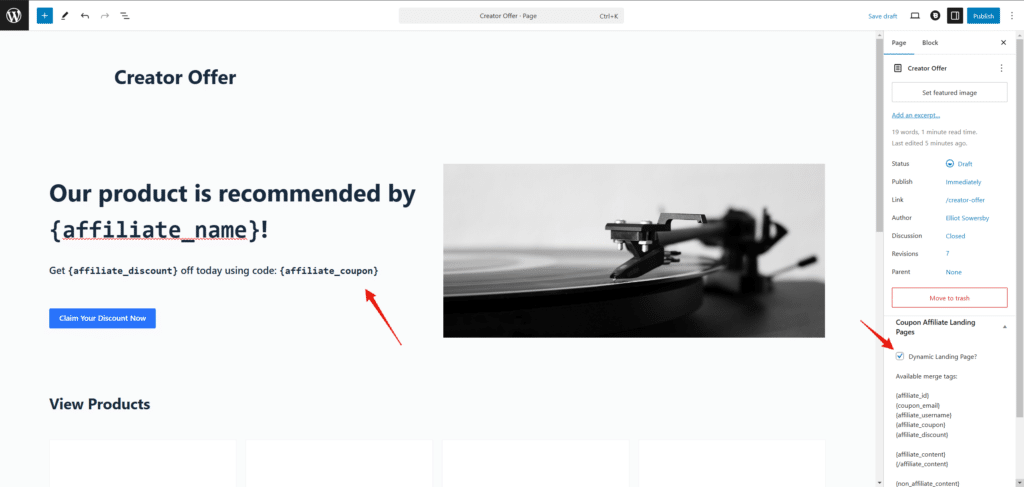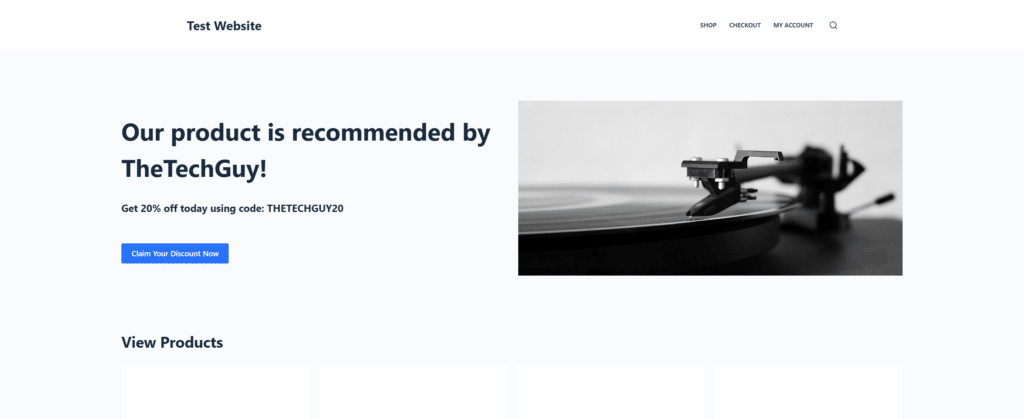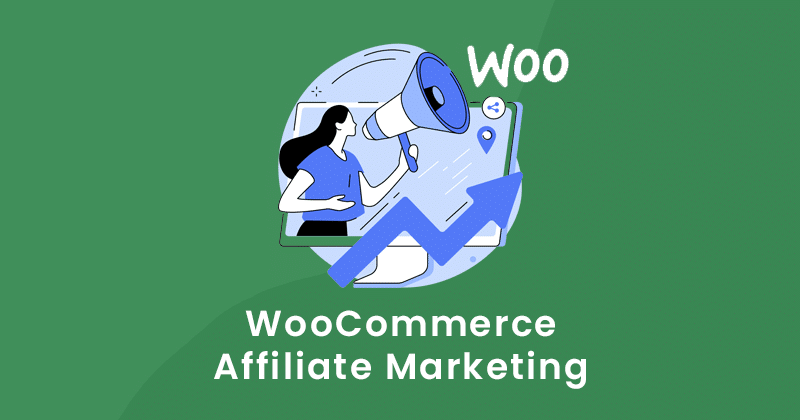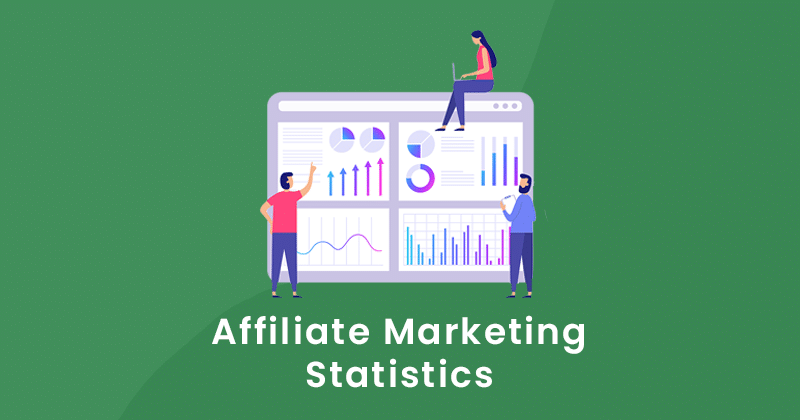How to Build Affiliate Landing Pages (Automatically)
Affiliate landing pages are an important part of successful affiliate marketing.
These pages serve as a personalised space for affiliates to promote your products or services, helping to drive traffic, engage visitors, and boost conversions.
In this guide, we’ll discuss how to build effective affiliate landing pages, what to include, and how Dynamic Landing Pages in the Coupon Affiliates plugin can take your strategy to the next level.
1. How to Build Effective Affiliate Landing Pages
Affiliate landing pages are most effective when they’re tailored to a specific audience and designed with a clear goal in mind. Below are key elements to include and best practices to follow when building your pages.
Essential Elements of a Good Affiliate Landing Page
- Headline
Your headline is the first thing visitors see. Make it engaging, relevant, and concise. It should clearly highlight the value of the offer.
Example: “Save 20% on All Products – Use Your Exclusive Coupon Code Today!” - Subheadline
Use a brief subheadline to elaborate on the offer and encourage the visitor to keep reading.
Example: “Limited-time discount for our loyal customers. Don’t miss out!” - Call-to-Action (CTA)
Place your primary CTA prominently above the fold. Use action-oriented text, like:- “Claim Your Discount Now”
- “Shop and Save”
- “Get 20% Off Today”
- Coupon Code Display
Clearly display the affiliate’s coupon code so it’s easy for visitors to see and use. Highlight it in bold or in a visually distinct way. - Offer Details
Provide a short description of the discount or promotion. Include details such as the percentage or amount off, applicable products, and the expiration date. - Benefits and Features
Explain why visitors should choose your product. Use bullet points to highlight key benefits or features that solve their problems or meet their needs. - Social Proof
Include customer reviews, testimonials, or influencer endorsements to build trust. - Visuals
Use high-quality images or videos that showcase your product or service in action. People respond better to visuals than to plain text.
Tips for Designing Affiliate Landing Pages
- Keep It Simple
Avoid clutter. Focus the design on the offer and the CTA. Use plenty of white space to guide visitors’ attention. - Responsive Design
Ensure your page is mobile-friendly. Many visitors will access the page on their phones, so make sure the layout adapts seamlessly. - Optimise Page Speed
Slow-loading pages lead to high bounce rates. Use lightweight images and test your page’s speed using tools like Google PageSpeed Insights. - Brand Consistency
Align the page’s design and tone with your brand to reinforce trust and recognition. - Track and Analyse Performance
Use analytics to monitor the page’s performance. Track metrics such as click-through rates, conversion rates, and affiliate traffic.
By incorporating these elements and best practices, you’ll create high-converting affiliate landing pages that effectively engage visitors and encourage them to take action.
2. What Are Dynamic Landing Pages?
While traditional affiliate landing pages are effective, Dynamic Landing Pages take things a step further by automatically personalising the content for each affiliate. This advanced feature in the Coupon Affiliates plugin allows you to create a single landing page template that generates customised pages for your affiliates.
Key Features:
- Personalised Content: Merge tags dynamically replace placeholders with affiliate-specific details, such as their name, coupon code, or discount value.
- Automated Page Generation: Affiliates receive unique landing page URLs without additional setup.
- Referral Integration: Landing pages act as referral links, applying the coupon code automatically and setting referral cookies.
Example:
If your landing page template has the slug /special-deal/ and an affiliate’s coupon code is thetechguy, their unique URL would be:
www.example.com/special-deal/thetechguyWhen a visitor clicks this link, they see a customised page showing the affiliate’s name, discount, and coupon code.
3. Setting Up Dynamic Landing Pages
Here’s how to create and enable Dynamic Landing Pages with the Coupon Affiliates plugin.
Step 1: Enable the Landing Pages Feature
- Navigate to Coupon Affiliates > Settings
- Go to the “Modules” or the “Referral URLs” settings tab.
- Enable the Landing Pages feature.
- Save your changes.
Step 2: Create a Landing Page Template
- Go to Pages > Add New in your WordPress dashboard.
- Design your page using your favourite builder (e.g., Elementor, Divi, or the block editor).
- On the right side, see the “Coupon Affiliate Landing Page” meta box, and enable the “Dynamic Landing Page?” option.
- Insert merge tags where dynamic content should appear:
{affiliate_name}: Displays the affiliate’s name.{affiliate_coupon}: Shows the affiliate’s coupon code.{affiliate_discount}: Displays the discount value.
Our product is recommended by {affiliate_name}! Get {affiliate_discount} off today using code: {affiliate_coupon}.

Step 3: Share Affiliate URLs
Affiliates will automatically see their unique landing page URL in the Referral URLs tab of their dashboard.
For example:
www.example.com/special-deal/thetechguyWhen they share these links, visitors see a personalised page with their referring affiliates details, and the referral will be tracked for that affiliate.

4. Why Use Dynamic Landing Pages?
Dynamic Landing Pages are ideal for managing affiliate marketing campaigns at scale. Here’s why they’re a must-have:
Benefits:
- Scalability: Generate hundreds of customised pages using one template.
- Time-Saving: Automate personalisation and URL creation for affiliates.
- Increased Engagement: Personalised content resonates more with visitors.
- Referral Integration: Simplify the customer journey by applying discounts automatically.
5. Best Practices for Dynamic Landing Pages
To maximise conversions with Dynamic Landing Pages, follow these tips:
Design:
- Use visually engaging layouts with clear CTAs.
- Optimise for mobile devices to ensure accessibility.
Content:
- Include testimonials or success stories for social proof.
- Highlight the affiliate’s connection to the brand (e.g., “Recommended by {affiliate_name}”).
Testing:
- Test each merge tag to ensure it displays correctly.
- Preview pages using different affiliate URLs to confirm personalisation.
6. Tracking and Measuring the Success of Affiliate Landing Pages
To optimise your affiliate marketing strategy, it’s essential to track the performance of your landing pages. By analysing key metrics, you can identify what works and refine your pages for better results.
Important Metrics to Monitor:
- Traffic Sources: Identify where visitors are coming from (e.g., social media, email campaigns, or search engines).
- Click-Through Rate (CTR): Measure the percentage of visitors who click on your call-to-action.
- Conversion Rate: Track how many visitors complete the desired action, such as making a purchase or signing up.
- Bounce Rate: Monitor the percentage of visitors who leave without interacting with the page.
- Average Session Duration: Determine how long visitors stay on the page to gauge engagement.
- Affiliate Performance: Compare which affiliates drive the most traffic and conversions.
Tools to Help You Track Performance:
- Google Analytics: Set up goals to track conversions and analyse traffic behaviour.
- Coupon Affiliates Plugin Analytics: Use built-in reporting to monitor affiliate-specific performance, including coupon usage and referral traffic.
- A/B Testing Tools: Plugins like Thrive Optimize let you test different headlines, CTAs, or designs to find the most effective combination.
Tips for Improving Performance Based on Data:
- Adjust page content or layout to reduce bounce rates.
- Focus on high-performing affiliates and provide additional resources to maximise their results.
- Test different offers or visuals to improve CTR and conversion rates.
- Use insights to refine your targeting strategy for future campaigns.
By closely monitoring these metrics, you’ll gain valuable insights into what drives success and make data-informed decisions to continuously improve your affiliate landing pages.
7. Conclusion
Affiliate landing pages are an integral part of successful affiliate marketing campaigns. By combining best practices for page design and content with the power of Dynamic Landing Pages, you can create highly personalised experiences that boost conversions and strengthen affiliate relationships.
The Coupon Affiliates plugin simplifies this process, allowing you to build scalable, customised landing pages that automatically adjust to each affiliate. Whether you’re managing a small group of influencers or a large affiliate network, Dynamic Landing Pages help you achieve more with less effort.
Learn more: Dynamic Landing Pages Documentation
Start building your personalised landing pages today and watch your affiliate programme thrive!
Elliot Sowersby is a WordPress developer from Yorkshire, United Kingdom. He is the founder and lead developer of Coupon Affiliates and RelyWP.




Leave a Reply